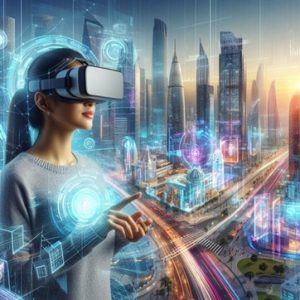Augmented Reality (AR) and Virtual Reality (VR) are transformative technologies that blur the lines between the physical and digital worlds, offering immersive and interactive experiences that engage our senses and reshape how we perceive and interact with information. From gaming and entertainment to education, healthcare, and enterprise, AR and VR are revolutionizing industries and unlocking new possibilities for innovation, collaboration, and storytelling.
Understanding Augmented and Virtual Reality
- Augmented Reality (AR): AR overlays digital content onto the real world, enhancing our perception of reality by adding virtual elements such as images, text, or animations. AR experiences can be delivered through smartphones, tablets, smart glasses, and heads-up displays, providing users with contextual information and interactive experiences in real-time.
- Virtual Reality (VR): VR immerses users in fully virtual environments, transporting them to digital worlds and simulated experiences. VR technologies typically involve headsets or goggles that block out the physical world and replace it with computer-generated imagery and sounds, creating a sense of presence and immersion.

Key Applications and Industries
- Gaming and Entertainment: AR and VR revolutionize gaming and entertainment, offering immersive experiences, interactive storytelling, and new forms of gameplay. From immersive VR games to location-based AR experiences, these technologies provide endless opportunities for creativity and engagement.
- Education and Training: AR and VR transform education and training by providing immersive learning experiences, interactive simulations, and virtual laboratories. From virtual field trips to medical simulations and vocational training, these technologies enhance learning outcomes and engagement.
- Healthcare: In healthcare, AR and VR technologies enable medical professionals to visualize complex anatomical structures, perform surgical simulations, and enhance patient education and therapy. From training surgeons to treating phobias and PTSD, these technologies have significant applications in healthcare.
- Enterprise and Industry: AR and VR are reshaping the way businesses operate, from product design and manufacturing to marketing and customer service. These technologies enable virtual prototyping, remote collaboration, immersive sales experiences, and training simulations, driving efficiency and innovation across industries.
Benefits of Augmented and Virtual Reality
- Immersive Experiences: AR and VR offer immersive and engaging experiences that captivate users’ attention and stimulate their senses, leading to increased engagement and retention.
- Enhanced Visualization: AR and VR enable users to visualize complex data, concepts, and scenarios in intuitive and interactive ways, facilitating understanding and decision-making.
- Remote Collaboration: AR and VR technologies facilitate remote collaboration and communication, enabling teams to work together across distances and time zones as if they were in the same physical space.
- Training and Simulation: AR and VR provide realistic and risk-free environments for training and simulation, allowing users to practice skills, scenarios, and procedures in a safe and controlled setting.
